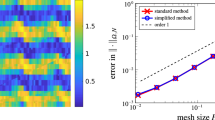Abstract
Continuous and discrete variations in material properties lead to substantial difficulties for most mesh-based methods for modeling and analysis of physical fields. The meshfree method described in this paper relies on distance fields to boundaries and to material features in order to represent variations of material properties as well as to satisfy prescribed boundary conditions. The method is theoretically complete in the sense that all distributions of physical properties and all physical fields are represented by generalized Taylor series expansions in terms of powers of distance fields. We explain how such Taylor series can be used to construct solution structures – spaces of functions satisfying the prescribed boundary conditions exactly and containing the necessary degrees of freedom to satisfy additional constraints. Fully implemented numerical examples illustrate the effectiveness of the proposed approach.
Similar content being viewed by others
References
A. Biswas and V. Shapiro, Approximate distance fields with non-vanishing gradients, Graphical Models 66 (2004) 133–159.
A. Biswas, V. Shapiro and I. Tsukanov, Heterogeneous material modeling with distance fields, Computer Aided Geom. Design 21(3) (2004) 215–242.
W. Cho, E.M. Sachs, N.M. Patrikalakis, M. Cima, H. Liu, J. Serdy and C.C. Stratton, Local composition control in solid freeform fabrication, in: Proc. of the 2002 NSF Design, Service and Manufacturing Grantees and Research Conf., San Juan, Puerto Rico (January 2002).
C. de Boor, A Practical Guide to Splines (Springer, Berlin, 2001).
A.I. Fedoseyev, M.J. Friedman and E.J. Kansa, Improved multiquadric method for elliptic partial differential equations via PDE collocation on the boundary, Comput. Math. Appl. 43(3–5) (2001) 491–500.
M. Freytag, V. Shapiro and I. Tsukanov, Field modeling with sampled data, Technical Report 2004-1, Spatial Automation Laboratory, http://sal-cnc.me.wisc.edu (2004).
K. Hollig, Finite Element Methods with B-Splines, Frontiers in Applied Mathematics, Vol. 26 (SIAM, Philadelphia, PA, 2003).
J.B. Holt, M. Koizumi, T. Hirai and Z.A. Munir, eds., Ceramic Transactions, Vol. 34 (Amer. Ceramic Soc., Westerville, OH, 1993).
J. Hoschek and D. Lasser, Fundamentals of Computer Aided Geometric Design (A.K. Peters, 1993).
T.R. Jackson, Analysis of functionally graded material object representation methods, Ph.D. thesis, MIT, Ocean Engineering Department (June 2000).
E.J. Kansa, Multiquadrics – a scattered data approximation scheme with applications to computational fluid dynamics: I. Surface approximations and partial derivative estimates, Comput. Math. Appl. 19(6–8) (1990) 127–145.
E.J. Kansa, Multiquadrics – a scattered data approximation scheme with applications to computational fluid dynamics: II. Solutions to parabolic, hyperbolic, and elliptic partial differential equations, Comput. Math. Appl. 19(6–8) (1990) 147–161.
L.V. Kantorovich and V.I. Krylov, Approximate Methods of Higher Analysis (Interscience, New York, 1958).
A.S. Kronrod, Nodes and Weights of Quadrature Formulas: Sixteen Place Tables (Consultants Bureau, New York, 1965).
H. Liu, W. Cho, T.R. Jackson, N.M. Patrikalakis and E.M. Sachs, Algorithms for design and interrogation of functionally gradient material objects, in: Proc. ASME 2000 IDETC/CIE 2000 ASME Design Automation Conf., Baltimore, MD (2000).
Y. Miyamoto, W.A. Kaysser and B.H. Rabin, eds., Functionally Graded Materials: Design, Processing and Applications (Kluwer Academic, Boston, 1999).
X. Qian and D. Dutta, Design of heterogeneous turbine blade, Computer-Aided Design 35 (2003) 319–329.
V.L. Rvachev, Geometric Applications of Logic Algebra (Naukova Dumka, Kiev, 1967) (in Russian).
V.L. Rvachev, Theory of R-functions and Some Applications (Naukova Dumka, Kiev, 1982) (in Russian).
V.L. Rvachev, T.I. Sheiko, V. Shapiro and I. Tsukanov, On completeness of RFM solution structures, Comput. Mech. 25 (2000) 305–316.
V.L. Rvachev, T.I. Sheiko, V. Shapiro and I. Tsukanov, Transfinite interpolation over implicitly defined sets, Computer Aided Geom. Design 18 (2001) 195–220.
N.S. Sapidis, Designing Fair Curves and Surfaces: Shape Quality in Geometric Modeling and Computer-Aided Design (SIAM, Philadelphia, PA, 1994).
V. Shapiro, Theory of R-functions and applications: A primer, Technical Report CPA88-3, Cornell University (November 1988).
V. Shapiro, Real functions for representation of rigid solids, Computer-Aided Geom. Design 11(2) (1994) 153–175.
V. Shapiro and I. Tsukanov, Implicit functions with guaranteed differential properties, in: 5th ACM Symposium on Solid Modeling and Applications, Ann Arbor, MI (1999).
D. Shepard, A two-dimensional interpolation function for irregularly spaced data, in: Proc. 23rd ACM National Conf. (1968) pp. 517–524.
Y.K. Siu and S.T. Tan, Modeling the material grading and structures of heterogeneous objects for layered manufacturing, Computer-Aided Design 34 (September 2002) 705–716.
Y.K. Siu and S.T. Tan, Source-based heterogeneous solid modeling, Computer-Aided Design 34 (January 2002) 41–55.
Yu.G. Stoian, V.S. Protsenko and G.P. Manko, Theory of R-functions and Actual Problems of Applied Mathematics (Naukova Dumka, Kiev, 1986) (in Russian).
I. Tsukanov and M. Hall, Fast forward automatic differentiation library (FFADLib): A user manual, Technical Report 2000-4, Spatial Automation Laboratory, http://sal-cnc.me.wisc.edu (2000).
I. Tsukanov and M. Hall, Data structure and algorithms for fast automatic differentiation, Internat. J. Numer. Methods Engrg. 56(13) (2003) 1949–1972.
I. Tsukanov and V. Shapiro, The architecture of SAGE – a meshfree system based on RFM, Engrg. Computers 18(4) (2002) 295–311.
D.F. Watson, Contouring: A Guide to The Analysis and Display of Spatial Data (Pergamon Press, Oxford, 1992).
S. Wolfram, The Mathematica, 4th ed. (Wolfram Media, 1999).
Author information
Authors and Affiliations
Corresponding author
Additional information
Communicated by Z. Wu and B.Y.C. Hon
Rights and permissions
About this article
Cite this article
Tsukanov, I., Shapiro, V. Meshfree modeling and analysis of physical fields in heterogeneous media. Adv Comput Math 23, 95–124 (2005). https://doi.org/10.1007/s10444-004-1835-3
Received:
Accepted:
Issue Date:
DOI: https://doi.org/10.1007/s10444-004-1835-3




